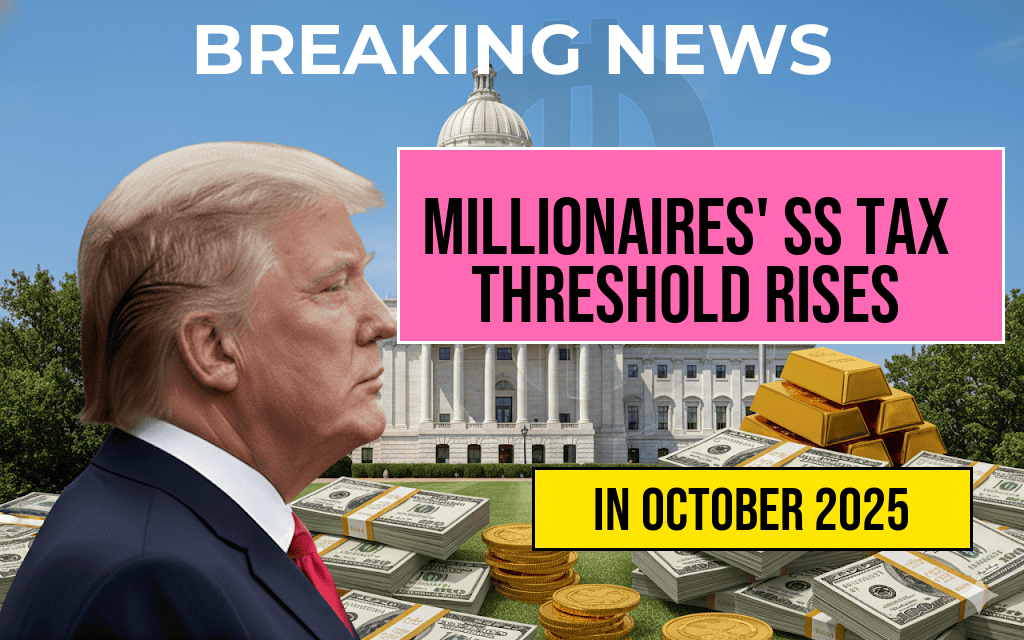Starting in 2024, higher-income earners will encounter increased thresholds for Social Security taxation, as the maximum taxable earnings rise to $373,000. This adjustment means that millionaires and high-wage earners will see a larger portion of their income subjected to Social Security payroll taxes. The Social Security Administration (SSA) announced the new figures earlier this year, reflecting annual updates based on national wage growth. For many individuals in the top income brackets, this change could influence their overall tax planning and retirement contributions. The increase aligns with ongoing efforts to balance the program’s financial sustainability while maintaining equitable taxation for earners across the income spectrum.
Background and Significance of the Social Security Tax Threshold
Understanding the Payroll Tax Cap
The Social Security payroll tax applies to earnings up to a specified maximum, known as the taxable wage base. As of 2024, this cap has increased to $373,000, up from $160,200 in 2023. Earnings beyond this threshold are not subject to Social Security payroll taxes, although they are still subject to Medicare taxes without a cap. This structure means high earners contribute a larger absolute amount to Social Security, but the proportion of their total income paid in taxes decreases as income rises.
Implications for High-Income Earners
The rise in the taxable wage base effectively extends the income level subject to Social Security taxes. For individuals earning more than $373,000, only income up to this point will be taxed for Social Security purposes. This change could lead to increased tax burdens for certain high-net-worth individuals, especially as their earnings approach or surpass the new cap. While the overall percentage of income paid remains lower than for lower and middle-income earners, the increased threshold means more income is now taxed, potentially affecting retirement planning and tax strategies.
Financial Impact and Broader Context
Changes in Social Security Revenue
| Income Level | Taxable Earnings Threshold | Additional Revenue Expected |
|---|---|---|
| High earners (>$373,000) | $373,000 | Increase in contributions from earnings between $160,200 and $373,000 |
| Middle-income earners | Up to $160,200 | Unchanged |
The adjustment aims to bolster Social Security’s solvency amid demographic shifts, including an aging population and longer life expectancy. According to estimates from the SSA, the increased cap could generate billions of additional dollars annually, helping to extend the program’s financial stability over the next few decades.
Tax Policy and Wealth Redistribution
While increasing the taxable wage base benefits the long-term sustainability of Social Security, critics argue that the change does little to address income inequality. High-income households often have access to tax planning strategies to reduce overall liabilities, and raising the cap may have limited impact on those with substantial earnings beyond the threshold. Nonetheless, the policy reflects a broader trend toward ensuring that the wealthiest contribute proportionally more to social programs.
Expert Perspectives and Future Outlook
Economic and Policy Experts’ Views
Economists suggest that raising the maximum taxable earnings aligns with inflation adjustments and wage growth, ensuring the program remains well-funded. Social Security experts emphasize that without such adjustments, the program could face funding shortfalls in the coming decades.
Potential Changes on the Horizon
Some policymakers advocate for further reforms, such as lifting the payroll tax cap altogether or implementing additional payroll taxes on the ultra-rich. Discussions around these measures continue amid ongoing debates about equitable funding and entitlement reforms.
What This Means for Taxpayers
- High earners will see a larger portion of their income subjected to Social Security taxes, potentially affecting their overall tax planning.
- Employers will also contribute at the higher rate for wages up to the new cap, influencing payroll expenses.
- Retirement planning professionals may advise clients to consider how the increased threshold impacts their future benefits and tax liabilities.
As the new threshold takes effect, individuals earning close to or above the $373,000 mark will need to review their financial strategies to optimize tax efficiency and retirement savings. The adjustment underscores the ongoing balancing act between funding social programs and managing tax burdens across different income groups.
Frequently Asked Questions
What is the new Social Security tax threshold for millionaires?
The Social Security tax threshold has increased for millionaires to accommodate the rise in the maximum earnings, now set at three hundred seventy-three thousand dollars.
How does the increase in the maximum earnings affect high-income earners?
The increase means that millionaires will face a higher Social Security tax threshold, potentially impacting their tax obligations by allowing more of their earnings to be taxed before reaching the cap.
Why has the Social Security maximum earnings threshold risen?
The threshold has risen in response to the cost of living adjustments and to ensure the Social Security system remains funded as incomes increase over time.
Will this change impact all earners equally?
No, this change primarily impacts high-income earners such as millionaires, while other earners below the threshold will not see changes in their Social Security tax.
How might this change affect my future Social Security benefits?
Since Social Security benefits are based on your earnings history, the increased tax threshold for millionaires could influence the overall funding and future benefit calculations.

Leave a Reply